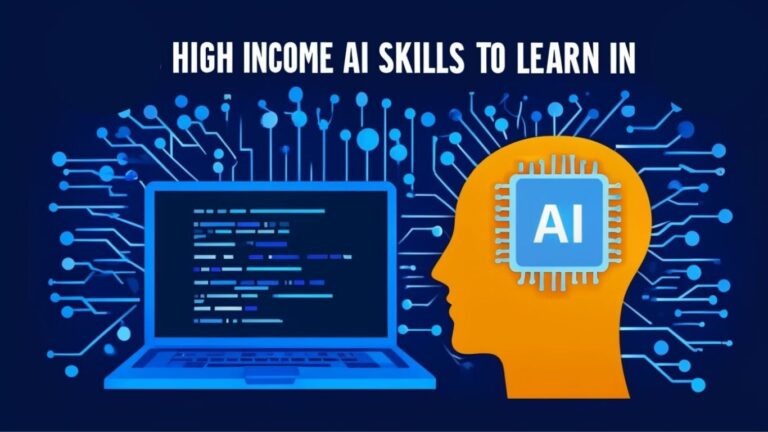Cybersecurity threats are becoming more complex and frequent, making traditional defenses less effective. That’s why AI in cybersecurity is gaining attention as a powerful solution. By leveraging advanced machine learning and intelligent algorithms, AI security solutions can detect threats faster, prevent hacking attempts, and adapt to new cyberattack methods.
In this blog, we’ll explore how AI for threat detection, AI for hacking prevention, and other AI-driven tools are transforming cyber defense. Discover how organizations are using cyber defense AI to protect sensitive data and stay ahead of cybercriminals in today’s digital world.
What is AI in Cybersecurity?
AI in cybersecurity refers to the use of machine learning, deep learning, and intelligent algorithms to improve how systems detect and respond to cyber threats. Unlike traditional security tools that follow static rules, AI security solutions can learn, adapt, and evolve in real time.
These systems analyze large volumes of data—from network activity to user behavior—to detect suspicious patterns. This makes AI for threat detection incredibly effective at spotting both known and unknown threats faster than human analysts.
With cyber defense AI, organizations can automate the identification of malware, phishing attacks, and even insider threats. AI models can assess risk levels instantly, allowing for immediate action before damage occurs.
As cyberattacks grow more complex, using AI for hacking prevention is no longer optional. It’s a critical part of a modern, proactive cybersecurity strategy. From AI-powered firewalls to smart anomaly detection tools, AI protection helps businesses stay one step ahead of attackers.
AI for Threat Detection and Prevention
One of the most significant advantages of AI in cybersecurity is its ability to dramatically improve the accuracy and speed of threat detection. Traditional methods often rely on manual monitoring or rule-based systems, which can miss subtle or new threats. In contrast, AI for threat detection uses machine learning algorithms to continuously analyze network data and spot unusual behavior in real time.
AI-powered tools are designed to detect anomalies across complex network environments. These include smart intrusion detection systems (IDS), behavior-based malware scanners, and automated phishing detection platforms. By examining vast amounts of data, cyber defense AI can identify patterns that indicate potential threats-often before they become serious breaches.
For example, AI systems can analyze login attempts to detect suspicious activity that might signal a brute force attack. Similarly, AI can monitor email traffic to flag phishing attempts by recognizing unusual language or sender behavior. These predictive capabilities make AI security solutions essential in preventing cyberattacks.
Real-world applications show the power of AI in action. Many organizations now use AI-driven platforms to combat ransomware outbreaks by isolating infected systems quickly. Others rely on AI to monitor user behavior for insider threats or unusual data access patterns, stopping breaches before sensitive information is compromised.
AI in Real-time Cyber Defense
In today’s fast-paced cyber threat landscape, AI in cybersecurity plays a crucial role in real-time monitoring and defense. Unlike traditional security tools that react after an attack, cyber defense AI works continuously to identify and stop threats as they happen.
AI-powered firewalls, intrusion detection systems (IDS), and antivirus tools are now equipped with machine learning models that analyze network traffic and system behavior instantly. These AI security solutions detect unusual activity and automatically respond to block malicious actions without waiting for human intervention.
One key advantage is AI’s ability to adapt and evolve. As hackers develop new techniques, AI systems learn from fresh data to improve detection accuracy. This means AI for threat detection stays ahead of emerging attack methods, such as zero-day exploits and advanced persistent threats (APTs).
By combining real-time analysis with rapid automated response, AI for hacking prevention significantly reduces the window of vulnerability. This dynamic defense approach is essential for protecting sensitive information and maintaining system integrity in an increasingly connected world.
AI for Hacking Prevention
AI in cybersecurity goes beyond detection—it actively prevents hacking attempts before they occur. Using advanced algorithms, AI for hacking prevention hunts for threats proactively, identifying vulnerabilities and suspicious activities early.
AI-driven threat hunting scans networks for hidden risks, spotting signs of attacks like DDoS or zero-day exploits before hackers strike. For example, AI can detect unusual traffic spikes indicating a DDoS attack or flag unknown software behavior that suggests zero-day vulnerabilities.
By anticipating and stopping attacks in advance, cyber defense AI helps organizations stay one step ahead of cybercriminals and protects critical systems from breaches.
Enhancing Security through Automation
AI in cybersecurity is transforming how routine security tasks are handled by automating processes like system patching and data analysis. This automation frees up security teams to focus on complex threats, improving overall efficiency.
AI-driven automation reduces operational costs by speeding up threat detection and response times. It also minimizes human error, which is a common cause of security breaches.
By automating repetitive tasks, AI security solutions ensure faster, more reliable protection, making cyber defense smarter and more cost-effective.
AI Security Solutions: The Future of Cyber Defense
The cybersecurity market is rapidly embracing AI security solutions as essential tools for defense. With cyber threats growing in scale and complexity, AI’s role in protecting networks and data is more important than ever.
Over the next 5 to 10 years, AI in cybersecurity is expected to evolve with advances like AI-powered quantum computing security and smarter threat intelligence platforms. Startups focusing on cyber defense AI are driving innovation, offering more sophisticated, adaptive protection.
However, integrating AI also brings challenges. Ethical concerns like data privacy, transparency, and potential bias must be addressed to ensure fair AI use. Balancing automation with human oversight will be key to deploying effective and responsible AI-driven cybersecurity solutions.
Limitations of AI in Cybersecurity
While AI in cybersecurity offers powerful benefits, it also has limitations. Over-reliance on AI can be risky, as attackers are developing adversarial techniques to fool AI systems and bypass defenses.
Human oversight remains essential. Cybersecurity experts must collaborate with AI tools to interpret results and make informed decisions, ensuring effective threat management.
Additionally, challenges like data privacy and AI bias can impact threat detection accuracy and fairness. Addressing these issues is critical to building trustworthy and reliable AI security solutions.
Conclusion
AI is reshaping cybersecurity by providing faster, smarter, and more adaptive defenses against evolving cyber threats. With AI in cybersecurity, organizations gain robust, dynamic, and scalable protection that traditional methods alone can’t match.
To stay secure in today’s digital world, it’s essential to keep up with the latest AI advancements and integrate AI security solutions into your defense strategy. Embracing AI-driven tools will help you prevent attacks, respond in real time, and build stronger cyber defenses for the future.






